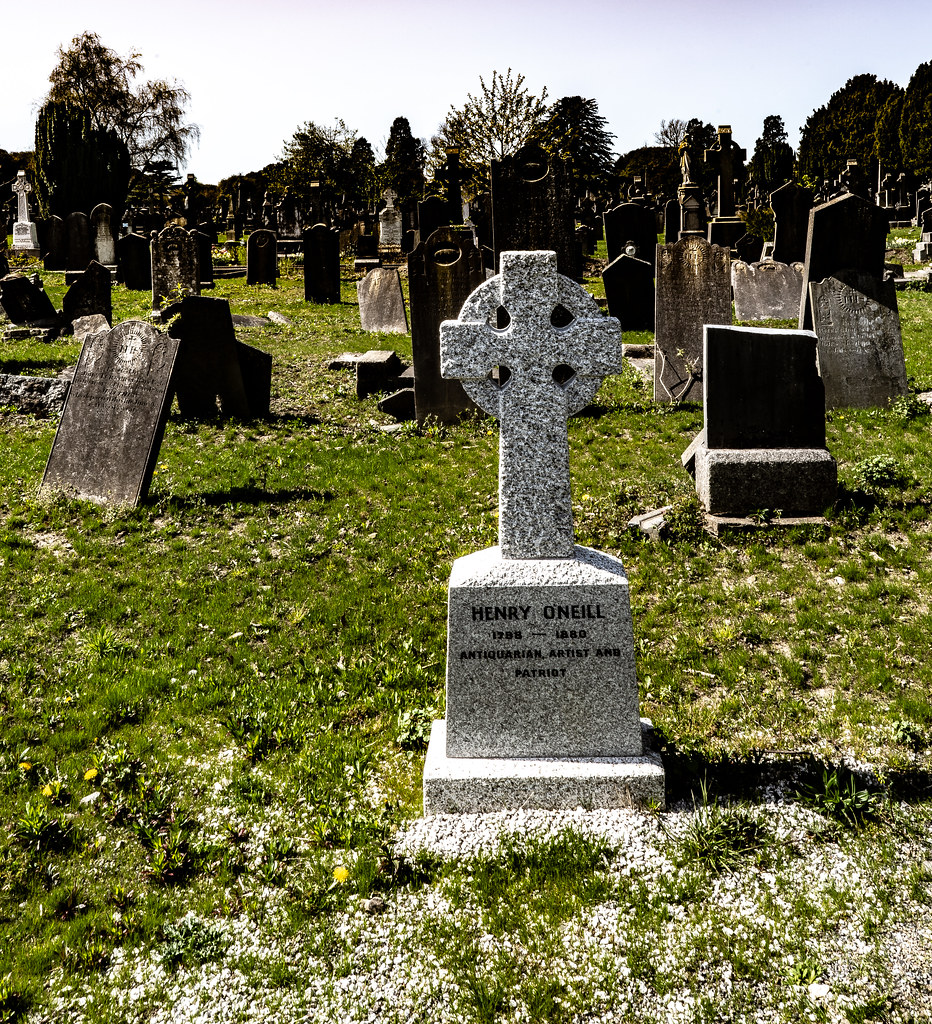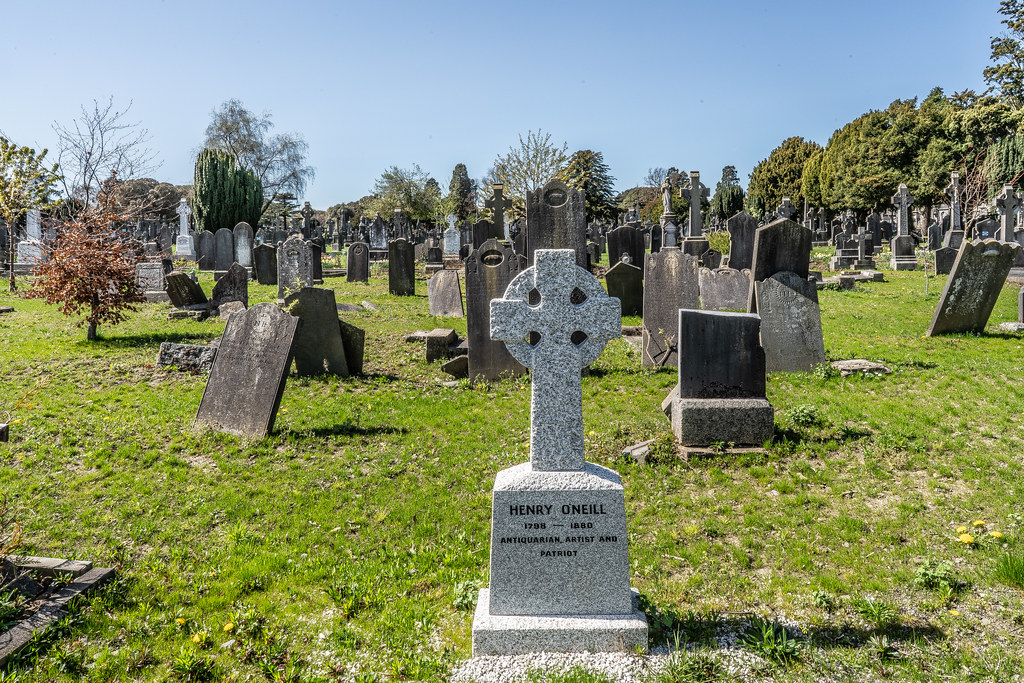GRAVE OF HENRY O'NEILL
Despite his fame Henry O'Neill died in poverty in 1880 and was buried in an unmarked grave in Glasnevin Cemetery. In 2016 a group of well-wishers came together to mark his grave with a Celtic Cross. While photographing in the cemetery I overheard the official cemetery historian discuss this with a number a visitors and some were less than impressed by the size of the cross especially as the cemetery features many really large Celtic Crosses.
Oscar Wilde made the world realise that it was O’Neill’s book on high crosses of 1857 that led to the Celtic cross becoming the popular form of tombstone throughout Ireland and beyond, and it was also Wilde who set up a fund to support the artist in his penurious old age, to which the British prime minister, William Ewart Gladstone, contributed.
Born in Clonmel, O'Neill lost both parents at a young age, and was tended by his sister, Sara O'Neill, a haberdasher who provided him an exceptional education.
As from childhood he had evinced a talent for drawing, he was placed as a pupil in the Dublin Society's Schools in 1815. He applied himself eagerly to his work, and carried off the first premiums in every class he competed in.
O'Neill identified himself with the popular political movements of the day, was a member of the Repeal Association, and during the imprisonment of O'Connell in Richmond gaol he painted a group of the Liberator and his fellow-prisoners, and later he did the well-known series of lithograph portraits of the Young Irelanders, Smith O'Brien and others.
In 1863 was published his "Fine Arts of Ancient Ireland," illustrated with seven chromo-lithographs by himself and wood-cuts by G. Hanlon, an ambitious work on the antiquities of Ireland, in which he attempted to refute the conclusions of Petrie in his "Ecclesiastical Architecture of Ireland," and maintained the pagan origin of the Round Towers.
In 1868 he published a brochure, "Ireland for the Irish," attacking landlordism. He projected a work on the Round Towers, of which only the first part, relating to the county of Dublin, was published: "The Round Towers of Ireland, by Henry O'Neill. Part the First, containing descriptions of the four Round Towers in the county of Dublin," published by M. H. Gill and Son, Sackville Street, 1877.
His last work was a lithograph of the Cross of Cong. O'Neill was a constant exhibitor at the Royal Hibernian Academy down to 1879. Most of his works were in water-colour, but he occasionally painted in oils. O'Neill is best remembered for the creation of lithographs portraying Celtic art and crosses in Ireland. They were published as Illustrations of Some of the Most Interesting Sculptured Crosses of Ancient Ireland (1859).
Oscar Wilde made the world realise that it was O’Neill’s book on high crosses of 1857 that led to the Celtic cross becoming the popular form of tombstone throughout Ireland and beyond, and it was also Wilde who set up a fund to support the artist in his penurious old age, to which the British prime minister, William Ewart Gladstone, contributed.
Born in Clonmel, O'Neill lost both parents at a young age, and was tended by his sister, Sara O'Neill, a haberdasher who provided him an exceptional education.
As from childhood he had evinced a talent for drawing, he was placed as a pupil in the Dublin Society's Schools in 1815. He applied himself eagerly to his work, and carried off the first premiums in every class he competed in.
O'Neill identified himself with the popular political movements of the day, was a member of the Repeal Association, and during the imprisonment of O'Connell in Richmond gaol he painted a group of the Liberator and his fellow-prisoners, and later he did the well-known series of lithograph portraits of the Young Irelanders, Smith O'Brien and others.
In 1863 was published his "Fine Arts of Ancient Ireland," illustrated with seven chromo-lithographs by himself and wood-cuts by G. Hanlon, an ambitious work on the antiquities of Ireland, in which he attempted to refute the conclusions of Petrie in his "Ecclesiastical Architecture of Ireland," and maintained the pagan origin of the Round Towers.
In 1868 he published a brochure, "Ireland for the Irish," attacking landlordism. He projected a work on the Round Towers, of which only the first part, relating to the county of Dublin, was published: "The Round Towers of Ireland, by Henry O'Neill. Part the First, containing descriptions of the four Round Towers in the county of Dublin," published by M. H. Gill and Son, Sackville Street, 1877.
His last work was a lithograph of the Cross of Cong. O'Neill was a constant exhibitor at the Royal Hibernian Academy down to 1879. Most of his works were in water-colour, but he occasionally painted in oils. O'Neill is best remembered for the creation of lithographs portraying Celtic art and crosses in Ireland. They were published as Illustrations of Some of the Most Interesting Sculptured Crosses of Ancient Ireland (1859).

GRAVE OF HENRY O'NEILL 001

GRAVE OF HENRY O'NEILL 002
You will find links to buy products from Amazon, Google and other partners. If you click on these links, you’ll find that the URL includes a small extra piece of text which identifies that the click came from my websites. This text is an affiliate code, and it means that I get a small percentage of the money you spend if you choose to buy that product, or, in some cases, other products from the site soon after. These affiliate links help pay the costs of producing my websites and ensure that the content is free to you.
COPYRIGHT INFORMATION BELOW APPLIES ONLY TO PHOTOGRAPHS

This work by William Murphy aka Infomatique is licensed under a Creative Commons Attribution-NonCommercial-ShareAlike 4.0 International License.
Permissions beyond the scope of this license may be available at https://excellentstreetimages.com/in-the-year-twentytwenty/copyright/.
